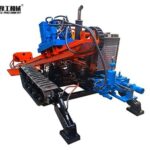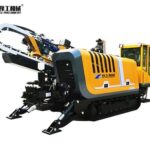HDD equipment, short for horizontal directional drilling equipment, is a steerable trenchless method of installing underground pipelines, conduits, and cables with minimal environmental impact and surface disruption. This makes it the preferred choice for projects under roads, rivers, buildings, and environmentally sensitive areas. HDD machine encompasses the powerful machinery and specialized tools used throughout this process, from the initial pilot bore to the final product pullback. As industries increasingly prioritize environmental preservation and operational efficiency, HDD systems have become indispensable tools for modern construction projects.
Features of Modern HDD Equipment
Modern HDD systems incorporate advanced technologies that enhance performance and operational efficiency:
- Precise Navigation Systems: Real-time tracking and GPS guidance ensure accuracy in complex underground environments.
- High Torque and Thrust Capacity: Enables drilling through hard soils and rocky terrains.
- Eco-Friendly Design: Minimal surface disruption, reduced emissions, and efficient mud recycling.
- Compact Structure: Portable and versatile for both urban and remote site applications.
- Intelligent Control Systems: Digital dashboards for monitoring torque, rotation speed, pressure, and drilling angle.
Structure and Main Components of HDD Machine
HDD equipment consists of several key components, each playing an essential role in ensuring efficient drilling performance:
- Drilling Rig: The heart of the HDD system, responsible for providing thrust, rotation, and pulling force during drilling operations.
- Drill Rods and Pipes: These hollow pipes transmit drilling fluid and mechanical power from the rig to the drill head.
- Drill Head and Steering Tool: Equipped with a cutting bit and steering mechanism, it determines the direction and angle of drilling.
- Power Unit: Typically powered by diesel engines or electric motors, providing energy to drive all hydraulic and mechanical systems.
- Reaming Tools: Used after pilot drilling to enlarge the borehole to the desired diameter.
- Pullback Assembly: Connects the product pipe to the drill string during the final stage of pullback.
Advantages of Using Horizontal Directional Drilling Equipment
- Minimal Surface Disruption: HDD equipment is ideal for urban areas, roads, and landscaped environments.
- Environmental Protection: Reduces soil erosion and vegetation damage.
- Cost and Time Efficiency: Shortens project timelines and lowers restoration costs.
- Accuracy and Reliability: Advanced navigation systems ensure precise underground drilling.
- Versatility: Capable of handling various ground conditions, including clay, sand, and rock.
How Does A HDD Rig Work?
The operation of HDD equipment is a carefully choreographed process in three main stages.
- The first stage is the Pilot Hole. The drill rig pushes the drill string, with the downhole assembly attached, into the ground at a shallow angle. The operator on the rig uses the guidance system to track the location and orientation of the drill head. By carefully rotating the drill string and engaging the steerable mud motor, the operator can navigate the bore path around obstacles and along a pre-designed route, creating a small-diameter pilot hole from the entry point to the exit point.
- Once the pilot hole is complete, the second stage, Pre-reaming, begins. The drill string is pulled back toward the rig, and a reamer is attached to the end. This tool is pulled back through the pilot hole, enlarging it to a diameter suitable for the product pipe or conduit that will be installed. Multiple passes with progressively larger reamers may be necessary to achieve the desired bore diameter without destabilizing the ground.
- The final stage is the Pullback. It is attached to the reamer and the drill string via a swivel, which prevents the rotational force from being transferred to the pipe. The drill rig then initiates the pullback operation, retracting the drill string while simultaneously pulling the new pipeline or conduit through the enlarged borehole in a single, continuous action.



